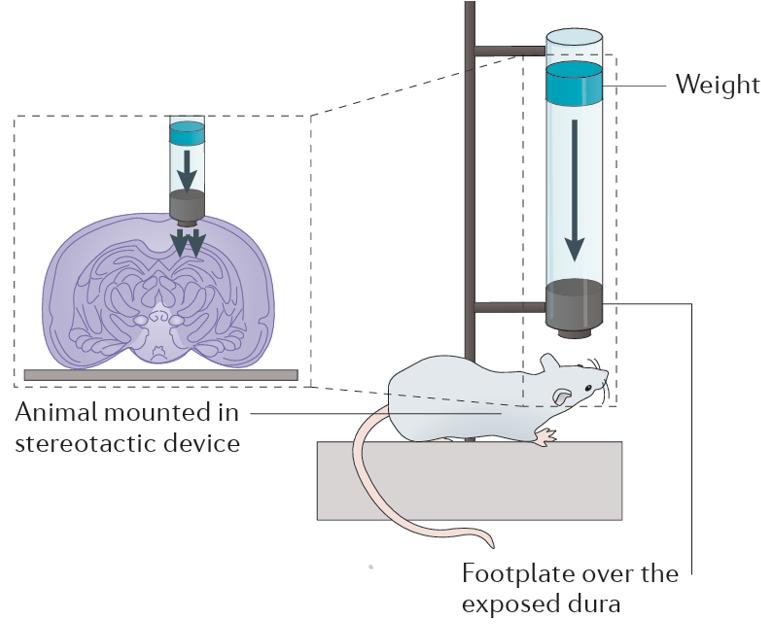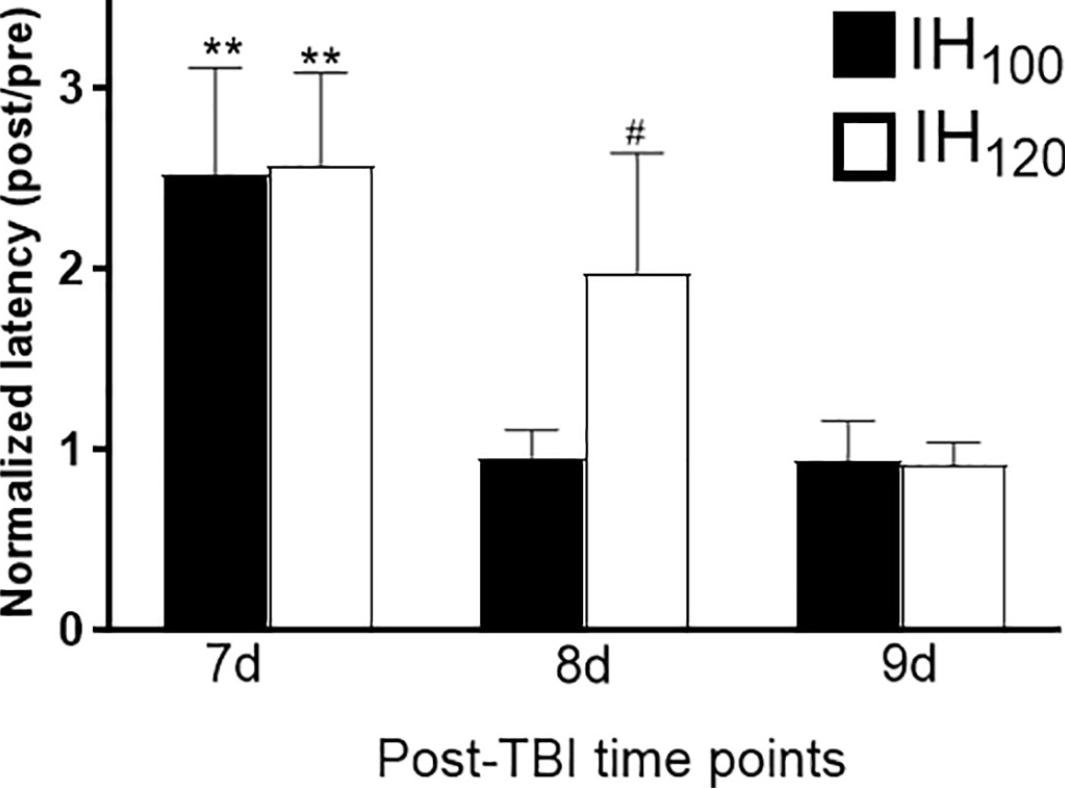Weight-Drop Model
If you're looking to gain a better understanding of the pathophysiology of traumatic brain injury (TBI) or develop a therapy for TBI, Creative Bioarray has the solution for you. We have established a highly effective weight drop model that can help you obtain accurate and reliable results about your test compounds. Our weight drop model for TBI is designed with precision and care to give you detailed insights into the mechanism of TBI and assist you in your research endeavors. With our cutting-edge technology and expertise, you can rest assured that you are in good hands.
The weight drop model has been an indispensable tool in neuroscience research for several decades. This model has significantly contributed to our understanding of the pathophysiology of TBI. In the weight drop model, the skull is exposed to a free falling, guided weight. Injury severity in this model can be altered by adjusting the mass of the weight and the height from which it falls.
 Fig. 1 Weight drop model of TBI
Fig. 1 Weight drop model of TBI
Our Weight Drop Model
- Available Animal
Rat - Group Setting
- Sham group
- Model group
- Three dose groups of the test compound
- Endpoints
- Body weight
- Behavioral tests: Rotarod test, Morris water maze, etc.
- Histology analysis: H&E staining
- Clinical score: mNSS score
- Brain water content
- Other customized endpoints: available upon request
……
Example Data
 Fig. 2 Effect of IH100 and IH120 TBI on Barnes maze (BM) performance.
Fig. 2 Effect of IH100 and IH120 TBI on Barnes maze (BM) performance.
Additionally, we provide other TBI rodent models that you may be interested in:
Quotation and Ordering
Creative Bioarray, as a leading provider of disease models, offers a range of services to our clients, including assistance with designing studies that are tailored to their specific goals. By working with us, you can be sure that your studies will be designed to maximize the amount of data that can be obtained from a single animal. So, whether you are looking to conduct basic research or develop new therapies, we are here to help. If you are interested in our services, please feel free to contact us at any time or submit an inquiry to us directly. We look forward to cooperating with you.
References
- Xiong, Y., et al. Animal models of traumatic brain injury. Nat Rev Neurosci. 2013; 14: 128–142.
- Chakraborty, N., et al. TBI weight-drop model with variable impact heights differentially perturbs hippocampus-cerebellum specific transcriptomic profile. Exp Neurol. 2021, 335:113516.
For research use only. Not for any other purpose.
Disease Models
- Oncology Models
-
Inflammation & Autoimmune Disease Models
- Rheumatoid Arthritis Models
- Glomerulonephritis Models
- Multiple Sclerosis (MS) Models
- Ocular Inflammation Models
- Sjögren's Syndrome Model
- LPS-induced Acute Lung Injury Model
- Peritonitis Models
- Passive Cutaneous Anaphylaxis Model
- Delayed-Type Hypersensitivity (DTH) Models
- Inflammatory Bowel Disease Models
- Systemic Lupus Erythematosus Animal Models
- Oral Mucositis Model
- Asthma Model
- Sepsis Model
- Psoriasis Model
- Atopic Dermatitis (AD) Model
- Scleroderma Model
- Gouty Arthritis Model
- Carrageenan-Induced Air Pouch Synovitis Model
- Carrageenan-Induced Paw Edema Model
- Experimental Autoimmune Myasthenia Gravis (EAMG) Model
- Graft-versus-host Disease (GvHD) Models
-
Cardiovascular Disease Models
- Surgical Models
- Animal Models of Hypertension
- Venous Thrombosis Model
- Atherosclerosis model
- Cardiac Arrhythmia Model
- Hyperlipoidemia Model
- Doxorubicin-induced Heart Failure Model
- Isoproterenol-induced Heart Failure Model
- Arterial Thrombosis Model
- Pulmonary Arterial Hypertension (PAH) Models
- Heart Failure with Preserved Ejection Fraction (HFpEF) Model
-
Neurological Disease Models
- Alzheimer's Disease Modeling and Assays
- Seizure Models
- Parkinson's Disease Models
- Ischemic Stroke Models
- Acute Spinal Cord Injury (ASCI) Model
- Traumatic Brain Injury (TBI) Model
- Hypoxic-Ischemic Encephalopathy (HIE) Model
- Tourette Syndrome (TS) Model
- Amyotrophic Lateral Sclerosis (ALS) Model
- Huntington's Disease (HD) Model
- Intracerebral hemorrhage (ICH) Models
- Schizophrenia Model
- Pain Models
-
Metabolic Disease Models
- Type 1 Diabetes Mellitus Model
- Type 2 Diabetes Mellitus Model
- Animal Model of Hyperuricemia
-
Nonalcoholic Fatty Liver Disease Model
- High-Fat Diet-Induced Nonalcoholic Fatty Liver Disease (NAFLD) Model
- Methionine and Choline Deficient (MCD) Diet-Induced Nonalcoholic Fatty Liver Disease (NAFLD) Model
- Gubra-Amylin NASH (GAN) Diet-Induced Nonalcoholic Fatty Liver Disease (NAFLD) Model
- Streptozotocin (STZ) Induced Nonalcoholic Fatty Liver Disease (NAFLD) Model
- High Fat Diet-Induced Obesity Model
- Diabetic Foot Ulcer (DFU) Model
- Liver Disease Models
- Rare Disease Models
- Respiratory Disease Models
- Digestive Disease Models
-
Urology Disease Models
- Cisplatin-induced Nephrotoxicity Model
- Unilateral Ureteral Obstruction Model
- 5/6 Nephrectomy Model
- Renal Ischemia-Reperfusion Injury (RIRI) Model
- Diabetic Nephropathy (DN) Models
- Passive Heymann Nephritis (PHN) Model
- Adenine-Induced Chronic Kidney Disease (CKD) Model
- Kidney Stone Model
- Doxorubicin-Induced Nephropathy Model
- Orthotopic Kidney Transplantation Model
- Orthopedic Disease Models
- Ocular Disease Models
- Skin Disease Models
- Infectious Disease Models
- Otology Disease Models